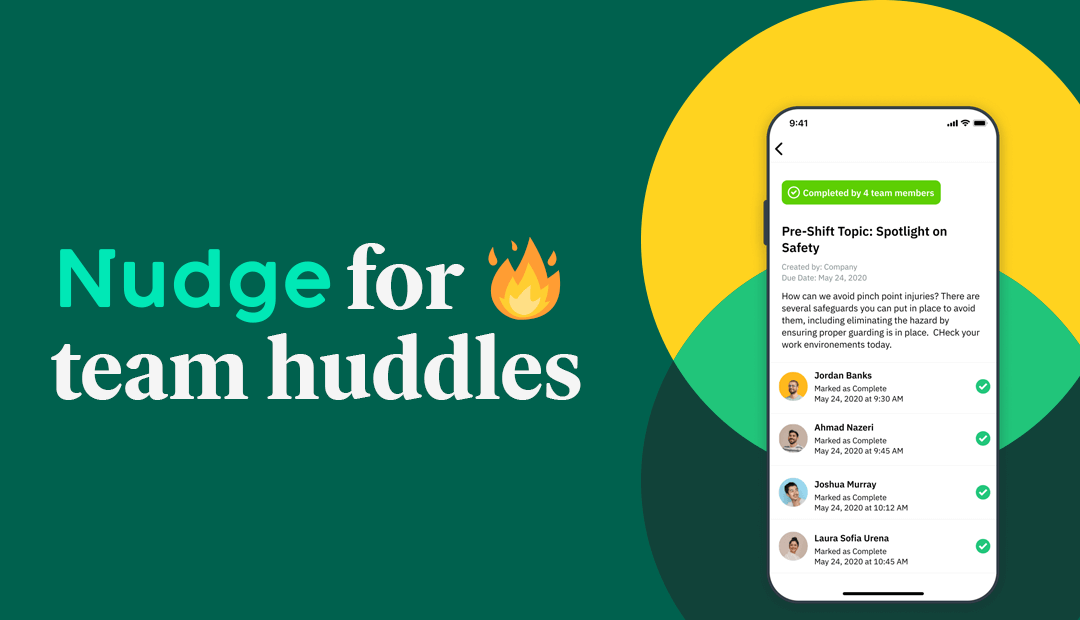
5 ways to take your team huddles to the next level with Nudge
Ah, team huddles. Loved by many for driving organizational consistency, collecting employee feedback, aligning on goals, and so much more. These pint-sized pre-shift meetings are the perfect chance for retail and restaurant teams to quickly connect every day on recent updates, hurdles, or other goings on.
But they also have challenges. Any time you’re bringing communication down to the location level, you’re at risk of information getting reinterpreted or filtered – or missing staff altogether, if a team member misses a huddle. It can be hard for managers or head office to track who knows what, and whether every location covered the critical updates they need to share. Plus, there’s the typical meeting challenges, like stronger personalities dominating and groupthink taking over.
Luckily, we’re here to help! As Nudge’s Intermediate Product Manager (Jessie 👋) and Senior Customer Success Manager (Andreas 👋), we’ve got almost 10 years of experience helping Nudge customers get the most out of their frontline communications – and their team huddles.
Here are 5 ways to take your team huddles to the next level:
1. Use Nudge as your 🔥 team huddle tool
Are we biased? Yes. Is Nudge a frontline organization’s best-kept secret when it comes to running next-level team huddles. Also yes!
Nudge is perfect for organizations looking to scale up their team huddles to ensure that every single employee is on the same page. You can use our task feature as a team meeting checklist. Head office can add items they want every location to cover in their huddle, and then managers can add their own items specific to their location (they can even choose items from a pre-populated list of huddle topics!). You can assign each item to every worker to ensure they check it off once they’ve read it, or you can assign specific info to specific workers on a need-to-know basis.
In the team huddle, managers and employees open up Nudge and review the items for the day, checking them off as they go. This helps huddles to run faster and more effectively, because managers can spend more time on team building and addressing issues versus relaying information. The huddle checklist also ensures managers can track who has received the updates, ensuring full, consistent visibility across your workforce (no matter how big!) while still avoiding duplication of information.
2. Leverage data to optimize your team huddles at scale
It’s no secret that we love workforce analytics. Making data-driven decisions is critical for frontline organizations looking to optimize their processes and drive operational efficiency. The same goes for your team huddles. Using a tool like Nudge ensures that every team huddle can be easily tracked through our analytics dashboards, so you can see at a glance what’s being added to team huddles, and what topics need more attention – and steer the conversation accordingly. You can even see what items are getting checked off and when, to get full visibility on how information is getting disseminated. Pair this with a resource hub and knowledge-testing questions, and you have the ability to check the confidence and preparedness of your entire workforce. Magical, right?
Data can also help to drive execution. If you know which locations are consistently doing team huddles (and which are lagging) you can celebrate the behavior you want to drive. Acknowledge the teams that are making team huddles a daily ritual as a way to gently nudge (see what we did there?) other locations to follow suit.
3. Be descriptive, but clear
Think about the last time you made an elevator pitch: simplicity is your friend. Whether you’re adding huddle items to your checklist at the head office level, or working with your location managers to add their own items, focus on being clear and concise.
That said, don’t leave out too much detail. After all, if there’s one thing The Deskless Report taught us, you can’t over-share with your staff. Ensure your teams know exactly what they need to do, but keep it focused. A great way to ensure your team huddle items are on track is to focus on driving an outcome, not a theoretical idea. Staying outcome-oriented will keep your team huddles short and sweet – and keep your staff’s attention focused!

Want to dive even deeper into the world of team huddles? Read our Ultimate Guide to Frontline Team Huddles for everything you need to get started, including example agendas, CS-approved tips, and more!
4. Find the right mix of operations and engagement
Team huddles can be the most special five minutes of a team’s day…if your locations use it right. The best huddles have a good mix of operations (company announcements, menu updates, health and safety protocols) and engagement (team member shout-outs, anniversaries, feedback). Hot tip: You can take this engagement a step further with Nudge through our Cheers peer recognition pins and our Chat feature to follow up on conversations, questions, or feedback that emerges in your huddles.
Ensure the business needs are being met, but don’t be afraid to encourage your location managers to have some fun and create some micro engagement moments with their staff. After all, that’s the benefit of using Nudge to streamline team huddles in the first place – you’re opening up more time for engagement and connection building.
5. Empower, don’t audit
One final word of warning: while scaling up your team huddles with Nudge allows for head office to have greater visibility on what’s being discussed, it’s important to use this oversight properly. It’s not about auditing individual locations or managers on how they’re running their team huddles, or calling out teams for not checking off huddle tasks. It’s about streamlining the process to ensure the right information is getting to the right people. If you add a crucial item to team huddles and the majority of locations don’t check it off, it’s an opportunity to learn more. Were teams confused by the update? Do they have questions? Is the organization sharing too much information each day and this item has to wait for the next huddle?
It’s also not about going above managers’ heads to share information. As we already mentioned, adding some tech to your team huddles allows managers to go through updates quickly and have more time to focus on engagement, hurdles, and connections – it empowers them to focus on truly leading their team.
The same is true at the manager level – instead of using the checklist to monitor team members on a daily basis, managers can use it to track general huddle effectiveness and ensure that information is getting to every employee, empowering them to do their best, every day.
––
Pre-shift team huddles can do wonders for frontline organizations – when teams use them effectively. We hope these tips help you take your team huddles to the next level 🚀.
